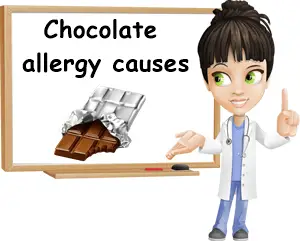What is chocolate allergy? Chocolate is a compound food made from several ingredients. As such, chocolate allergy is actually an allergic reaction to one or more of the ingredients used to make the product. The allergic reaction may be to cocoa, the caffeine in cocoa or a more common allergy such as one to milk, soy, corn and corn syrup, peanuts, hazelnuts, walnuts or other nuts or seeds, wheat and gluten used as binding agents or other ingredients such as dried fruits or food dyes and flavoring agents.
Sometimes, the adverse reactions you may experience after eating chocolate may not even be true allergy symptoms, but rather chocolate sensitivity symptoms or an intolerance to certain ingredients, often triggered by an existing gastrointestinal condition. The main difference between chocolate allergy and chocolate sensitivity is that an allergy comes with far greater risks than a sensitivity.

While some symptoms may overlap and a sensitivity or even intolerance may present with a skin rash, itching and redness, gastrointestinal symptoms such as mild stomach upset, headaches, fast heartbeat, palpitations, extrasystoles, shakiness or anxiety, true chocolate allergy may progress to life-threatening anaphylactic shock (or anaphylaxis). Anaphylactic shock is a medical emergency and requires immediate medical attention and treatment.
What are the causes of chocolate allergy?
Essentially all ingredients in chocolate hold a risk of allergic reaction, more so in people with multiple allergies. As such, causes include:
1) Cocoa bean allergy or cocoa allergy. All foods have allergenic potential, meaning they can potentially trigger allergic reactions following ingestion. The same is true for cocoa, obtained from cocoa beans along with cocoa butter and both used to make chocolate. An allergic reaction to cocoa beans or cocoa is possible, although extremely rare. Symptoms may range from eczema, hives, mild gastrointestinal upset to throat swelling, coughing, asthma and anaphylactic shock.
2) Peanuts, hazelnuts, walnuts and other nuts and seeds. These are some of the most common allergens in chocolate and not only. If a person experiences symptoms of an allergic reaction after eating chocolate, usually the first causes suspected are peanuts, nuts and seeds. These foods have the potential to trigger mild to severe allergic reactions, including anaphylactic shock. If you experience red, itchy skin or bumps on the skin, itchy throat, swelling of the lips, mouth or throat, palpitations, low blood pressure, headaches, lightheadedness, lethargy or any unusual symptoms after eating chocolate containing peanuts, nuts or seeds, seek medical help immediately because it may be possible you are experiencing an allergic reaction. Good to know: peanuts are actually not nuts, but legumes in the bean or pea family (hence the name pea-nuts). And the proteins they contain are what cause allergic reactions.

3) Soy allergy. One of the most common allergens worldwide, soy is often added to chocolate and all sorts of chocolate-based products, especially milk-chocolate. It may occur in the form of soy milk, soy protein, natural and artificial flavorings and soy lecithin. Soy milk and lecithin are two of the most common ingredients in chocolate. But the proteins in soy have the potential to trigger mild to severe allergic reactions, possibly concluding with anaphylactic shock. Soy is a legume just like peanuts and beans.
4) Milk allergy. Proteins in milk are known to trigger allergic reactions of various degrees in some people. And most chocolate contains milk or milk protein in varying amounts, from milk chocolate to dark chocolate. People with allergy to milk proteins should read the label carefully and avoid chocolate varieties that either list milk or milk products as ingredients or warn of possible milk presence as a result of contamination from shared processing equipment.
5) Corn and corn syrup allergy. Corn syrup is made from corn starch (also called maize starch). Nowadays it’s being used as a low-cost sweetening agent and for other purposes in all kinds of processed foods, including chocolate products (example: chocolate syrup). In chocolate, corn syrup may be used to enhance flavor, control sugar crystallization, improve texture and other uses. And since corn is a rare, but known food allergen with the potential for anaphylaxis, its by-products present in chocolate are a cause for allergic reactions in some people.
6) Wheat allergy. Wheat proteins such as gluten may be used as binding agents in various chocolate products. And although rare, wheat allergy is possible and has the potential to cause severe symptoms culminating with anaphylaxis. Having a wheat allergy can also predispose to other allergies to grains that contain proteins with a similar make-up as those in wheat.
7) Nickel allergy. Nickel is naturally present in cocoa and the resulting chocolate. It is considered a contaminant and cocoa beans are tested to make sure nickel content is well below a certain threshold. If too much is present, it has both toxic and allergenic potential. Cocoa, chocolate, nuts and some legumes are high in nickel. Allergy to this particular metal may cause a skin reaction or systemic response, depending on whether the metal comes into contact with the skin or is ingested with food.
Other potential allergens in chocolate include various fruits, especially berries like strawberries, sweet fillings like strawberry jam or jams made of berry mixes, but also food dyes and flavoring agents like sulfites, corn syrup, milk or soy protein etc.
How does chocolate allergy affect us?
The reason why chocolate allergy represents such a concern is because it causes a systemic reaction, meaning it affects multiple systems. The most affected is the immune system which then engages the respiratory, gastrointestinal, cardiovascular and even nervous system. What basically happens is the immune system perceives an otherwise harmless element in chocolate as something that may cause infection and disease. So it over-reacts. And this over-reaction of the immune system engages a cascade of smaller scale reactions that result in inflammation. Sometimes, the inflammation can be so extensive, that even the airways swell and breathing is affected. This hypersensitivity reaction can become life-threatening.
Chocolate allergy symptoms may be mild to severe and include:
1) Skin symptoms. Chocolate allergy rash is usually the first and most notable skin reaction. Redness, itching, hives (red, itchy bumps on the skin) may occur. Edema with swelling of the face is possible.
2) Symptoms affecting the eyes, nose, ears. Watery eyes, redness and itching, runny nose with clear mucus (see What Nose Mucus Color Means), sneezing, air fullness (see 11 Causes of Ear Fullness).
3) Gastrointestinal symptoms. Stomach upset, nausea, vomiting sensation, bloating, abdominal cramps, diarrhea.
4) Cardiovascular symptoms. Palpitations, extrasystoles, low blood pressure causing dizziness or fainting sensation, cardiac arrest.
5) Nervous system symptoms. Headaches, migraines, anxiety, panic attack.
6) Respiratory symptoms. Coughing, wheezing breath sounds, shortness of breath, swelling of the mouth or throat, laryngeal edema, laryngospasms, asthma episodes. Unexplained tiredness and lethargy may occur.
7) Anaphylactic shock (anaphylaxis). Essentially life-threatening if not reversed with medication (usually epinephrine). Anaphylaxis may have a rapid onset, for example almost immediately after eating chocolate. It may also occur as a delayed reaction, several hours and up to 48 hours following exposure to the allergen.
Chocolate allergy may sometimes be mistaken for other conditions
1) Caffeine and theobromine sensitivity. Caffeine is present in cocoa as well as another compound with a similar action called theobromine. Eating too much dark chocolate may cause symptoms such as palpitations, extrasystoles and other arrhythmia manifestations, racing heart or rapid heart rate (tachycardia), anxiety, agitation, insomnia etc. Caffeine may also irritate the gastrointestinal system and lead to acid reflux or diarrhea.
2) Sensitivity or intolerance to chocolate ingredients. Also generically called chocolate sensitivity or intolerance, it refers to adverse reactions similar to, but milder than allergic reactions (that also don’t end in anaphylactic shock). The adverse reactions occur in response to proteins in wheat (like gluten), corn and other cereals, proteins in milk and soy, sulfites (for extending shelf life, enhancing flavor, color, also used in dried fruits) or heavy metals.
Existing conditions like celiac disease and gluten sensitivity, lactose intolerance, irritable bowel syndrome, Crohn’s disease, gastritis may trigger chocolate sensitivity or intolerance symptoms.
3) Heavy metal contamination. Lastly, cocoa may contain heavy metals (and possible carcinogens) such as cadmium, nickel and aluminium. If consumed in excess, there are risks of heavy metal contamination.
Treatment options
The best treatment if avoidance of allergens. If an allergy is suspected, it is strongly advised to avoid chocolate in all forms and products. If you are allergic to a specific ingredient, choose varieties that specifically state they are free of said ingredient. If the ingredients list say there is a probable or possible contamination with milk, soy or other such elements you may be allergic to, or if the chocolate has been processed in a factory or using a machine that also processes foods you are allergic to, it is best to avoid the product.
If you experience allergy symptoms, seek medical assistance immediately. In case of a sensitivity or intolerance, either avoid eating chocolate, choose better varieties lacking certain ingredients that may trigger adverse reactions like milk or soy or limit intake to amounts of chocolate that do not cause side effects.
